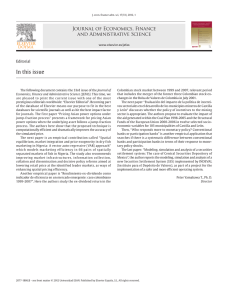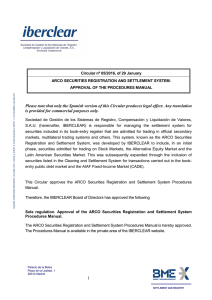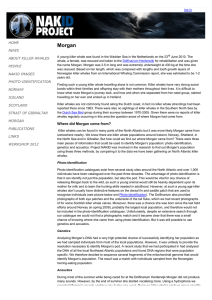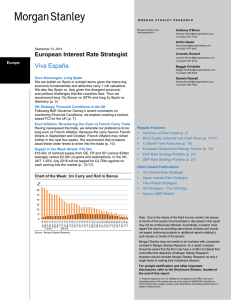Spain is back
Anuncio
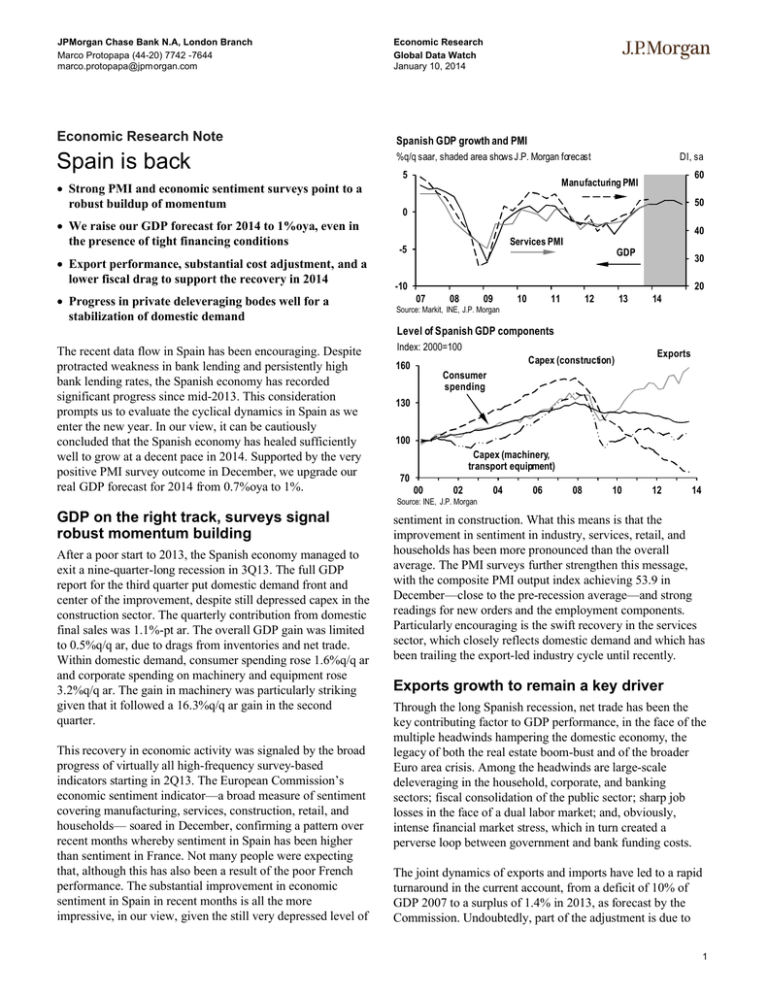
JPMorgan Chase Bank N.A, London Branch Marco Protopapa (44-20) 7742 -7644 [email protected] Economic Research Global Data Watch January 10, 2014 Economic Research Note Spanish GDP growth and PMI Spain is back %q/q saar, shaded area shows J.P. Morgan forecast Strong PMI and economic sentiment surveys point to a robust buildup of momentum We raise our GDP forecast for 2014 to 1%oya, even in the presence of tight financing conditions Export performance, substantial cost adjustment, and a lower fiscal drag to support the recovery in 2014 Progress in private deleveraging bodes well for a stabilization of domestic demand 5 DI, sa 60 Manufacturing PMI 50 0 40 Services PMI -5 GDP 30 -10 20 07 08 09 10 11 12 13 14 Source: Markit, INE, J.P. Morgan Level of Spanish GDP components The recent data flow in Spain has been encouraging. Despite protracted weakness in bank lending and persistently high bank lending rates, the Spanish economy has recorded significant progress since mid-2013. This consideration prompts us to evaluate the cyclical dynamics in Spain as we enter the new year. In our view, it can be cautiously concluded that the Spanish economy has healed sufficiently well to grow at a decent pace in 2014. Supported by the very positive PMI survey outcome in December, we upgrade our real GDP forecast for 2014 from 0.7%oya to 1%. Index: 2000=100 Capex (construction) 160 Exports Consumer spending 130 100 Capex (machinery, transport equipment) 70 00 02 04 06 08 10 12 14 Source: INE, J.P. Morgan GDP on the right track, surveys signal robust momentum building After a poor start to 2013, the Spanish economy managed to exit a nine-quarter-long recession in 3Q13. The full GDP report for the third quarter put domestic demand front and center of the improvement, despite still depressed capex in the construction sector. The quarterly contribution from domestic final sales was 1.1%-pt ar. The overall GDP gain was limited to 0.5%q/q ar, due to drags from inventories and net trade. Within domestic demand, consumer spending rose 1.6%q/q ar and corporate spending on machinery and equipment rose 3.2%q/q ar. The gain in machinery was particularly striking given that it followed a 16.3%q/q ar gain in the second quarter. This recovery in economic activity was signaled by the broad progress of virtually all high-frequency survey-based indicators starting in 2Q13. The European Commission’s economic sentiment indicator—a broad measure of sentiment covering manufacturing, services, construction, retail, and households— soared in December, confirming a pattern over recent months whereby sentiment in Spain has been higher than sentiment in France. Not many people were expecting that, although this has also been a result of the poor French performance. The substantial improvement in economic sentiment in Spain in recent months is all the more impressive, in our view, given the still very depressed level of sentiment in construction. What this means is that the improvement in sentiment in industry, services, retail, and households has been more pronounced than the overall average. The PMI surveys further strengthen this message, with the composite PMI output index achieving 53.9 in December—close to the pre-recession average—and strong readings for new orders and the employment components. Particularly encouraging is the swift recovery in the services sector, which closely reflects domestic demand and which has been trailing the export-led industry cycle until recently. Exports growth to remain a key driver Through the long Spanish recession, net trade has been the key contributing factor to GDP performance, in the face of the multiple headwinds hampering the domestic economy, the legacy of both the real estate boom-bust and of the broader Euro area crisis. Among the headwinds are large-scale deleveraging in the household, corporate, and banking sectors; fiscal consolidation of the public sector; sharp job losses in the face of a dual labor market; and, obviously, intense financial market stress, which in turn created a perverse loop between government and bank funding costs. The joint dynamics of exports and imports have led to a rapid turnaround in the current account, from a deficit of 10% of GDP 2007 to a surplus of 1.4% in 2013, as forecast by the Commission. Undoubtedly, part of the adjustment is due to 1 JPMorgan Chase Bank N.A, London Branch Marco Protopapa (44-20) 7742 -7644 [email protected] the collapse of imports, but the internal devaluation process— a sizable decline in unit labor costs—has played an important role in strengthening Spain’s external competitiveness. The export performance of the Spanish economy has indeed been remarkable. Export volumes have risen 19% since 2007, moving from 27% of GDP to 33% in 2013, driven by exports to non-Euro area countries. Importantly, the increase in exports has materialized under a relatively stable euro performance vis-á-vis trading partners, which further supports the role of cost adjustment as a major export driver. We expect this trend to persist over 2014. Economic Research Spain is back January 10, 2014 Spanish exports and exchange rates Index: 2000=100, sa 160 Index: 2000=100 120 115 Nominal effective exchange rate 140 110 120 105 Exports 100 100 80 95 00 However, the decline in unit labor costs has not been painless, as it has been driven by a fall in wages as well as a massive rise in the number of unemployed. Given that employment in the construction sector accounted for only 6% of the active labor force in 2013 compared to 13% in 2007, a large degree of labor shedding, especially of less protected temporary workers, was unavoidable. The labor market reform of 2012 has somewhat reduced the level of duality and made it easier to achieve wage flexibility, which, over time, may help the economy to reabsorb part of the unutilized labor force. Real effective exchange rate 180 02 04 06 08 10 12 14 Source: Eurostat, INE, J.P. Morgan Financing position of Spanish private sector and corporate margins % of GDP, 4-quarter moving sum 10 % of gross value added 44 Households net lending/borrowing 42 5 40 0 38 36 -5 Non financial corporations Net lending/borrowing -10 Gross operating surplus 34 32 Balance sheet repair bodes well for a stabilization of domestic demand -15 The possibility of a stronger contribution from domestic demand is supported not only by the encouraging pickup in capex, but also by the relatively successful deleveraging effort achieved by the private sector. private consumption in 3Q13 is encouraging. We think that the reinstatement of the Christmas bonus for public employees this year—in net terms about 0.5% of GDP once accounting for the reduction of personnel in the public sector—is important in supporting purchasing power, together with the stabilization of the unemployment rate and low inflation. Indeed, consumer confidence has improved quickly over recent months and the drawdown of accumulated wealth observed for three running quarters has come to a halt in 2Q13 (the latest available date for the sector flow of funds). Regarding banks, Spain has been given the green light by the Troika to exit its bank recapitalization program. Challenges remain, however. Deleveraging will continue for some time and non-performing loans (NPLs)—which lag the economic cycle—will continue to rise until domestic demand stabilizes at a decent level. But banks are judged to be well capitalized and liquidity conditions have sharply improved. In our view, the AQR process will make banks more cautious while they continue to provision and clean up their balance sheets during the review period. This should prevent a significant improvement in financing conditions for the corporate sector over most of 2014, so companies will remain reliant on internal sources of finance. Some comfort can be drawn from the large swing observed in the net financing position of Spanish companies and by stronger profit margins. The debt overhang legacy of the real estate bubble was most intense in the household sector. Deleveraging has been modest in terms of the adjustment in the stock of debt, as a share of gross disposable income; negative income growth has played havoc. But household deleveraging has been substantial in terms of flows and appears sustainable, especially if job creation resumes over 2014. The growth of 2 30 00 02 04 06 08 10 12 14 Source: INE, ECB, J.P. Morgan Conditions for growth in place, despite tight financing conditions In conclusion, it seems fair to acknowledge the remarkable adjustment achieved by the Spanish economy. In 2014, the economy will also take advantage of the milder fiscal stance allowed by the delay in achieving fiscal targets granted by the European Commission earlier in May. According to the government, the fiscal drag will be only 0.6% of GDP in 2014 versus 1% in 2013 (the European Commission estimates an even smaller fiscal drag of 0.3%) and the deficit target (5.8% of GDP) looks achievable. However, as mentioned, the drag from weak bank credit and high lending rates to corporates will not fade quickly. But, we believe the available evidence suggests that there is sufficient dynamism in the economy to resume growth even in the absence of a significant improvement in financing conditions. JPMorgan Chase Bank N.A, London Branch Marco Protopapa (44-20) 7742 -7644 [email protected] Economic Research Global Data Watch January 10, 2014 Disclaimer Analysts' Compensation: The research analysts responsible for the preparation of this report receive compensation based upon various factors, including the quality and accuracy of research, client feedback, competitive factors, and overall firm revenues. Principal Trading: JPMorgan and/or its affiliates normally make a market and trade as principal in fixed income securities discussed in this report. Legal Entities: J.P. Morgan is the global brand name for J.P. Morgan Securities LLC (JPMS) and its non-US affiliates worldwide. J.P. Morgan Cazenove is a brand name for equity research produced by J.P. Morgan Securities plc; J.P. Morgan Equities South Africa Proprietary Limited; JPMorgan Chase Bank, N.A., Dubai Branch; and J.P. Morgan Bank International LLC. J.P.Morgan Securities Inc. is a member of NYSE and SIPC. JPMorgan Chase Bank, N.A. is a member of FDIC. U.K.: JPMorgan Chase N.A., London Branch, is authorised by the Prudential Regulation Authority and is subject to regulation by the Financial Conduct Authority and to limited regulation by the Prudential Regulation Authority. Details about the extent of our regulation by the Prudential Regulation Authority are available from J.P. Morgan on request. J.P. Morgan Securities plc (JPMS plc) is a member of the London Stock Exchange and is authorised by the Prudential Regulation Authority and regulated by the Financial Conduct Authority and the Prudential Regulation Authority. J.P. Morgan Equities South Africa Proprietary Limited is a member of the Johannesburg Securities Exchange and is regulated by the Financial Services Board. J.P. Morgan Securities (Asia Pacific) Limited (CE number AAJ321) is regulated by the Hong Kong Monetary Authority. JPMorgan Chase Bank, N.A., Singapore branch and J.P. Morgan Securities Singapore Private Limited are regulated by the Monetary Authority of Singapore. JPMorgan Securities Japan Co., Ltd. is regulated by the Financial Services Agency in Japan. J.P. Morgan Australia Limited (JPMAL) (ABN 52 002 888 011/AFS Licence No: 238188) is regulated by ASIC and J.P. Morgan Securities Australia Limited (JPMSAL) (ABN 61 003 245 234/AFS Licence No: 238066) is regulated by ASIC and is a Market, Clearing and Settlement Participant of ASX Limited and CHIX. J.P.Morgan Saudi Arabia Ltd. is authorized by the Capital Market Authority of the Kingdom of Saudi Arabia (CMA), licence number 35-07079. General: Information has been obtained from sources believed to be reliable but JPMorgan does not warrant its completeness or accuracy except with respect to disclosures relative to JPMS and/or its affiliates and the analyst’s involvement with the issuer. Opinions and estimates constitute our judgment at the date of this material and are subject to change without notice. Past performance is not indicative of future results. The investments and strategies discussed may not be suitable for all investors; if you have any doubts you should consult your investment advisor. The investments discussed may fluctuate in price or value. Changes in rates of exchange may have an adverse effect on the value of investments. This material is not intended as an offer or solicitation for the purchase or sale of any financial instrument. JPMorgan and/or its affiliates and employees may act as placement agent, advisor or lender with respect to securities or issuers referenced in this report.. Clients should contact analysts at and execute transactions through a JPMorgan entity in their home jurisdiction unless governing law permits otherwise. This report should not be distributed to others or replicated in any form without prior consent of JPMorgan. U.K. and European Economic Area (EEA): Investment research issued by JPMS plc has been prepared in accordance with JPMS plc’s Policies for Managing Conflicts of Interest in Connection with Investment Research. This report has been issued in the U.K. only to persons of a kind described in Article 19 (5), 38, 47 and 49 of the Financial Services and Markets Act 2000 (Financial Promotion) Order 2001 (all such persons being referred to as “relevant persons”). This document must not be acted on or relied on by persons who are not relevant. Any investment or investment activity to which this document relates is only available to relevant persons and will be engaged in only with these persons. In other EEA countries, the report has been issued to persons regarded as professional investors (or equivalent) in their home jurisdiction. Japan: There is a risk that a loss may occur due to a change in the price of the shares in the case of share trading, and that a loss may occur due to the exchange rate in the case of foreign share trading. In the case of share trading, JPMorgan Securities Japan Co., Ltd., will be receiving a brokerage fee and consumption tax (shouhizei) calculated by multiplying the executed price by the commission rate which was individually agreed between JPMorgan Securities Japan Co., Ltd., and the customer in advance. Financial Instruments Firms: JPMorgan Securities Japan Co., Ltd., Kanto Local Finance Bureau (kinsho) No. 82 Participating Association / Japan Securities Dealers Association, The Financial Futures Association of Japan, Type II Financial Instruments Firms Association and Japan Investment Advisers Association. Australia: This material is issued and distributed by JPMSAL in Australia to “wholesale clients” only. This material does not take into account the specific investment objectives, financial situation or particular needs of the recipient. The recipient of this material must not distribute it to any third party or outside Australia without the prior written consent of JPMSAL. For the purposes of this paragraph the term “wholesale client” has the meaning given in section 761G of the Corporations Act 2001. New Zealand: This material is issued and distributed by JPMSAL in New Zealand only to persons whose principal business is the investment of money or who, in the course of and for the purposes of their business, habitually invest money. JPMSAL does not issue or distribute this material to members of "the public" as determined in accordance with section 3 of the Securities Act 1978. The recipient of this material must not distribute it to any third party or outside New Zealand without the prior written consent of JPMSAL. Canada: The information contained herein is not, and under no circumstances is to be construed as, a prospectus, an advertisement, a public offering, an offer to sell securities described herein, or solicitation of an offer to buy securities described herein, in Canada or any province or territory thereof. Any offer or sale of the securities described herein in Canada will be made only under an exemption from the requirements to file a prospectus with the relevant Canadian securities regulators and only by a dealer properly registered under applicable securities laws or, alternatively, pursuant to an exemption from the dealer registration requirement in the relevant province or territory of Canada in which such offer or sale is made. The information contained herein is under no circumstances to be construed as investment advice in any province or territory of Canada and is not tailored to the needs of the recipient. To the extent that the information contained herein references securities of an issuer incorporated, formed or created under the laws of Canada or a province or territory of Canada, any trades in such securities must be conducted through a dealer registered in Canada. No securities commission or similar regulatory authority in Canada has reviewed or in any way passed judgment upon these materials, the information contained herein or the merits of the securities described herein, and any representation to the contrary is an offense. Korea: This report may have been edited or contributed to from time to time by affiliates of J.P. Morgan Securities (Far East) Ltd, Seoul branch. Brazil: Ombudsman J.P. Morgan: 0800-7700847 / [email protected]. Revised December 7, 2013. Copyright 2014 JPMorgan Chase Co. All rights reserved. Additional information available upon request. 3

